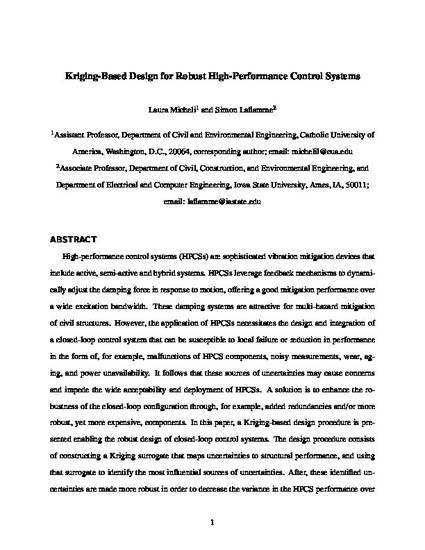
High-performance control systems (HPCS) are sophisticated vibration-mitigation devices that include active, semiactive, and hybrid systems. HPCS leverage feedback mechanisms to dynamically adjust the damping force in response to motion, offering a good mitigation performance over a wide excitation bandwidth. These damping systems are attractive for multihazard mitigation of civil structures. However, the application of HPCS necessitates the design and integration of a closed-loop control system that can be susceptible to local failure or reduction in performance in the form of, for example, malfunctions of HPCS components, noisy measurements, wear, aging, and power unavailability. It follows that these sources of uncertainties may cause concerns and impede the wide acceptability and deployment of HPCS. A solution is to enhance the robustness of the closed-loop configuration through, for example, added redundancies and/or more robust, yet more expensive, components. In this paper, a Kriging-based design procedure is presented enabling the robust design of closed-loop control systems. The design procedure consists of constructing a Kriging surrogate that maps uncertainties to structural performance, and using that surrogate to identify the most influential sources of uncertainties. After, these identified uncertainties are made more robust in order to decrease the variance in the HPCS performance over the lifetime of the structure. The performance of the HPCS is directly quantified through a life cycle cost analysis to obtain probability distributions on the expected financial impacts. The proposed procedure is demonstrated on a numerically simulated 39-story structure exposed to wind loads. Uncertainties in both the HPCS configuration (i.e., damping devices and sensors) and external load are considered. Results demonstrate that the proposed framework can be used to substantially improve the robustness of the closed-loop system. Also, through a comparison against a robust passive-viscous case, it is shown that robustly designed HPCS significantly outperform a passive system in terms of vibration mitigation and life cycle costs.
Available at: http://works.bepress.com/simon_laflamme/126/

This is a manuscript of an article published as Micheli, Laura, and Simon Laflamme. "Kriging-Based Design for Robust High-Performance Control Systems." ASCE-ASME Journal of Risk and Uncertainty in Engineering Systems, Part A: Civil Engineering 6, no. 4 (2020): 04020037. This material may be found at DOI: 10.1061/AJRUA6.0001085. Posted with permission.